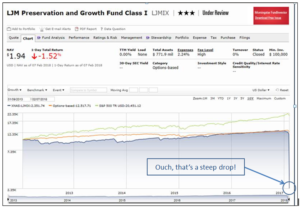
When Volatility Strikes – How to Assess the Latest Market Turbulence
After almost 2 years of calm and rising markets, last week reminded us that conditions can change quickly. Markets fell across the board as volatility roared back. The S&P 500, the Dow Jones Industrial Average, and the Nasdaq all fell by more than 5%. Is this a sign of things to come? How should investors position themselves in a potentially much more volatile market environment? We feel that this latest market correction is not a cause for alarm and that solid financial planning will go a long way in alleviating market concerns in any scenario.
What Happened?
The markets started the year strong, with the S&P 500 returning 5.62% in the month of January. Then, on Friday, February 2, the January jobs report came out better than expected. Good news, right? Well, hold on one minute.
Investors began to get nervous that perhaps the report was too good. Wages were up more than expected in the period and that could mean inflation would start accelerating. If that were the case, the Fed may have to keep raising interest rates in order to keep inflation under control. These thoughts were a little unsettling to traders and the Dow Jones Industrial Average finished Friday down 666 points – a bad omen for the week to come.
Monday morning the selling continued and it intensified throughout the day. The Dow Jones was down 1,600 points at one point in the session before closing down 1,100. It was the largest single-day point loss in market history, but the 4.16% decline was not historic as a percentage loss. That distinction belongs to October 19, 1987 when the Dow Jones declined 22.6%, the worst single day in its history.
The rest of the week felt like the aftershocks. I tend to think of the market like a rubber band. It went up for so long without any meaningful corrections that there was a lot of pent-up energy. The rubber band was being stretched. (For the investment geeks out there look up Minsky’s Financial Instability Hypothesis which says that the longer risk is not perceived in the market, the more potential risk builds). On Monday the rubber band was released and the market corrected. We then saw a bounce-back followed by volatile fluctuations, just as one might see in the rubber band.
By the end of the week, the market had erased its gains from January. The sudden spike in volatility had even more disastrous effects for investors betting that markets would remain calm.
Investors are constantly reminded that managers who seek outsized gains by taking extremely risky bets are playing a dangerous game. Take the LJM Preservation and Growth Fund (LJMIX) as pointed out in an article from Morningstar.com (link here). It has ‘Preservation’ in its name, but once volatility hit; it failed badly on that count, sinking over 80% in two days!
Figure 1: LJMIX charged 2.24% to obliterate investor capital
This case of LJM and other funds that got blindsided by last week’s market correction is that investors need to know where their risks exposures are. A fund called Preservation and Growth could easily fool some investors into thinking they had relatively low risk. After all, the fund did not have very big moves until all of a sudden it did. This was a failure of risk management on a massive scale.
What Comes Next?
The most likely scenario for financial markets is that markets remain volatile, at least for the near-term. Investors would do well to remember, that volatility in the market is normal. 2017 was the outlier in how calm it was. On average the market will see 2 or more 5% corrections in a year. Last year saw none.
It is important to note that these short-term fluctuations of the market are not as important to us as gauging the overall health of the economy and the earnings power of the underlying companies. On that front, we are still doing well. The economic data continues to improve and company earnings are growing at a strong pace. Furthermore, the dollar has been weakening against other currencies, which has been positive for U.S. companies exporting goods to foreign countries. A weak dollar makes those goods relatively cheaper in those markets. These are all reasons to be optimistic.
A major driver of markets for the rest of 2018 is likely to be the Federal Reserve. The Fed is expected to raise rates at their March meeting, but financial markets will be paying very close attention to any comments made by Fed officials in the meantime. They want to see if the expectation of 3 rate hikes for the year is still appropriate. The growing concern about inflation has some investors nervous that the Fed will have to hike more aggressively and raise rates more than 3 times. As I expressed in my prior piece on Monetary policy (link here), getting back to ‘normal’ policy could be a little upsetting to financial markets and add to the near-term volatility.
What Do We Do About It?
The short answer to the question about what our response is to these types of market moves will almost always be “be patient and continue to assess”. The trust department at Stillman Bank works to be proactive as opposed to being reactive. For instance, we were aware that increased volatility was possible and client portfolios were positioned accordingly. Our equity funds have a more conservative tilt to them than our benchmark and should outperform in down markets.
Any investor that has immediate cash needs would be wise to make sure that those are readily available. As famed investor Howard Marks says, one of the worst positions to be in as an investor is that of a forced seller. If volatility continues and someone needs cash at a time when the market corrects down, that could do damage to their financial plan. Better to have that cash available if you haven’t already.
We will continue to assess the situation and monitor how our managers are navigating this environment. We will adjust portfolios as we determine from new information coming in. There is nothing currently on our radar at the moment as we do not see much change in our outlook, other than prices are 7% cheaper than they were to end January.
Conclusion
Despite the jolt that market delivered this past week, we are not overly alarmed or expecting that it is a harbinger of a crash to come. As mentioned we have our risk management in place to be proactive and ready for these types of events, and the underlying data has not much changed in our opinion. We would plan to put more cash to work if the market were to drop much further from here.
Anyone who has done a decent job at financial planning should be completely un-phased by this type of market volatility. For those in the accumulation stage of their lives, (still socking money away for retirement) your contributions are now buying more stock than they did at the end of January. You are buying at a discount! For those in the distribution stage, (taking money out to live on) you should have a portfolio that is built to withstand these shocks. If a market decline of 10% gives you concern that you may not be able to accomplish your financial goals, it may be time to find a new financial planner.
We continue to monitor markets and work to place clients in the best possible position to achieve their financial goals. If you have any questions about our investing process or how the recent volatility has impacted your portfolio in particular, please feel free to reach out. I look forward to hearing from you.
Keith J. Akre, CFA, CFP® – Trust Officer
Opinions expressed are solely my own and do not express the views or opinions of Stillman Bank. Investments available through Stillman Trust & Asset Management (1) are not FDIC insured (2) are not deposits, obligations, or guaranteed by the bank and (3) are subject to investment risk including possible loss of principal.


